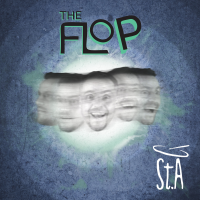Home » Jazz Musicians » Wardell Gray
Wardell Gray
Wardell Gray was one of the truly great, yet by now almost obscure, bebop tenor saxophonists. With a smooth mellow and consistent tone, he created a tenor style that veered from swing to bebop, a style that was elegant, sure-footed, mature and distinctive. His premature death under mysterious circumstances in 1955, robbed the jazz world of another unique player, and cast him into distant recollection, though his talent deserves greater recognition.
Born in Oklahoma City, Gray grew up in Detroit, playing locally as a teenager. He was a member of the Earl Hines big band during 1943-1945 before moving to Los Angeles in 1945. This was a big break, as the Hines orchestra was not only nationally-known, but it had also acted recently as a nursery for some of the emerging bebop musicians, including Dizzy Gillespie and Charlie Parker. Although most of these had left by the time Wardell joined, playing with the Hines band was still a marvelously lively and stimulating experience for the young Wardell. He spent around three years with Hines, and matured rapidly during this time, becoming a featured soloist and demonstrating a relaxed, fluent stylist very much in the Lester Young mold.
Wardell left Hines late in 1946, settling in Los Angeles; soon after arriving there, he recorded the first session under his own name, “One for Prez.” This was a quartet session, and on it Wardell had strong support from Dodo Marmarosa on piano, bassist Red Callender and drummer Chuck Thompson. The date though having a lot of repetitive takes, produced some excellent sides, notably “Easy Swing.”
While in Los Angeles, Wardell worked in a number of bands, notably with Benny Carter and with the small group that supported Billy Eckstine on a tour of the West Coast. But the real focus in LA at this time was in the clubs along Central Avenue, here Wardell found his element, playing in the mainly after-hours sessions in clubs like Jack's Basket Room, the Down Beat, Lovejoy's and the Club Alabam, and his early success in these sessions led Ross Russell to include him in a studio session he was organizing for his Dial label. The session was designed as a showcase for Charlie Parker, but Wardell acquitted himself superbly, showing no sign at all of being over-awed by Parker's presence. It was in the Central Avenue clubs that Wardell held his famous tenor battles with Dexter Gordon. These two were ideally matched: Wardell's light sound and swift delivery was more than a match for Dexter's big, blustering sound, and their tenor jousts became a kind of symbol for the Central Avenue scene. Their fame began to spread, and Ross Russell managed to get them to simulate one of their battles on “The Chase,” which became Wardell's first nationally-known recording.
Read moreTags
Discovering Wardell Gray: An Interview with Biographer Richard Carter

by Victor L. Schermer
Part 1 | Part 2 | Part 3 [This is one of two interviews and an article intended to bring readers' attention to the under-recognized tenor saxophonist, Wardell Gray, whose brief career spanned the transition from swing to bebop and whose life was cut short by sudden and tragic circumstances.] Richard Carter is a London writer and jazz aficionado who, as a college student, was first taken by Wardell Gray's recordings in the 1950s, around the ...
Continue ReadingWardell Gray, "Forgotten Tenor:" An Interview with Filmmaker Abraham Ravett

by Victor L. Schermer
Part 1 | Part 2 | Part 3 [This is one of two interviews and an article intended to bring readers' attention to the revered but neglected tenor saxophonist, Wardell Gray, whose brief career spanned the transition from swing to bebop and whose life was cut short by sudden and tragic circumstances.] Swing and early bebop saxophonist Wardell Gray, despite exciting beginnings, had for all practical purposes vanished from the jazz radar until filmmaker Abraham Ravett ...
Continue ReadingWhy the World Should Remember Wardell Gray

by Victor L. Schermer
Part 1 | Part 2 | Part 3 [This article is a commentary to accompany All About Jazz interviews about Wardell Gray with filmmaker Abraham Ravett and biographer Richard Carter, all of which are intended to bring readers' attention to this outstanding but under-recognized tenor saxophonist whose brief career spanned the transition from swing to bebop and whose life was cut short by sudden and tragic circumstances. In the interviews, filmmaker Abraham Ravett and biographer Richard Carter provide ...
Continue ReadingJazz Musician of the Day: Wardell Gray

Source:
Michael Ricci
All About Jazz is celebrating Wardell Gray's birthday today!
Wardell Gray was one of the truly great, yet by now almost obscure, bebop tenor saxophonists. With a smooth mellow and consistent tone, he created a tenor style that veered from swing to bebop, a style that was elegant, sure-footed, mature and distinctive. His premature death under mysterious circumstances in 1955, robbed the jazz world of another unique player, and cast him into distant recollection, though his talent deserves greater recognition. ...
read more
Jazz Musician of the Day: Wardell Gray

Source:
Michael Ricci
All About Jazz is celebrating Wardell Gray's birthday today!
Wardell Gray was one of the truly great, yet by now almost obscure, bebop tenor saxophonists. With a smooth mellow and consistent tone, he created a tenor style that veered from swing to bebop, a style that was elegant, sure-footed, mature and distinctive. His premature death under mysterious circumstances in 1955, robbed the jazz world of another unique player, and cast him into distant recollection, though his talent deserves greater recognition. ...
read more
Jazz Musician of the Day: Wardell Gray

Source:
Michael Ricci
All About Jazz is celebrating Wardell Gray's birthday today!
Wardell Gray was one of the truly great, yet by now almost obscure, bebop tenor saxophonists. With a smooth mellow and consistent tone, he created a tenor style that veered from swing to bebop, a style that was elegant, sure-footed, mature and distinctive. His premature death under mysterious circumstances in 1955, robbed the jazz world of another unique player, and cast him into distant recollection, though his talent deserves greater recognition. ...
read more
Jazz Musician of the Day: Wardell Gray

Source:
Michael Ricci
All About Jazz is celebrating Wardell Gray's birthday today!
Wardell Gray was one of the truly great, yet by now almost obscure, bebop tenor saxophonists. With a smooth mellow and consistent tone, he created a tenor style that veered from swing to bebop, a style that was elegant, sure-footed, mature and distinctive. His premature death under mysterious circumstances in 1955, robbed the jazz world of another unique player, and cast him into distant recollection, though his talent deserves greater recognition. ...
read more
Jazz Musician of the Day: Wardell Gray

Source:
Michael Ricci
All About Jazz is celebrating Wardell Gray's birthday today!
Wardell Gray was one of the truly great, yet by now almost obscure, bebop tenor saxophonists. With a smooth mellow and consistent tone, he created a tenor style that veered from swing to bebop, a style that was elegant, sure-footed, mature and distinctive. His premature death under mysterious circumstances in 1955, robbed the jazz world of another unique player, and cast him into distant recollection... Read more.
Place our Musician of ...
read more
Jazz Musician of the Day: Wardell Gray

Source:
Michael Ricci
All About Jazz is celebrating Wardell Gray's birthday today!
Wardell Gray was one of the truly great, yet by now almost obscure, bebop tenor saxophonists. With a smooth mellow and consistent tone, he created a tenor style that veered from swing to bebop, a style that was elegant, sure-footed, mature and distinctive. His premature death under mysterious circumstances in 1955, robbed the jazz world of another unique player, and cast him into distant recollection... Read more.
Place our Musician of ...
read more
Jazz Musician of the Day: Wardell Gray

Source:
Michael Ricci
All About Jazz is celebrating Wardell Gray's birthday today!
Wardell Gray was one of the truly great, yet by now almost obscure, bebop tenor saxophonists. With a smooth mellow and consistent tone, he created a tenor style that veered from swing to bebop, a style that was elegant, sure-footed, mature and distinctive. His premature death under mysterious circumstances in 1955, robbed the jazz world of another unique player, and cast him into distant recollection... Read more.
Place our Musician of ...
read more
Jazz Musician of the Day: Wardell Gray

Source:
Michael Ricci
All About Jazz is celebrating Wardell Gray's birthday today!
Wardell Gray was one of the truly great, yet by now almost obscure, bebop tenor saxophonists. With a smooth mellow and consistent tone, he created a tenor style that veered from swing to bebop, a style that was elegant, sure-footed, mature and distinctive. His premature death under mysterious circumstances in 1955, robbed the jazz world of another unique player, and cast him into distant recollection... Read more.
Place our Musician of ...
read more
Jazz Musician of the Day: Wardell Gray

Source:
Michael Ricci
All About Jazz is celebrating Wardell Gray's birthday today! Wardell Gray was one of the truly great, yet by now almost obscure, bebop tenor saxophonists. With a smooth mellow and consistent tone, he created a tenor style that veered from swing to bebop, a style that was elegant, sure-footed, mature and distinctive. His premature death under mysterious circumstances in 1955, robbed the jazz world of another unique player, and cast him into distant recollection... Read more. Place our Musician of ...
read more
Jazz Musician of the Day: Wardell Gray

Source:
Michael Ricci
All About Jazz is celebrating Wardell Gray's birthday today!
Wardell Gray was one of the truly great, yet by now almost obscure, bebop tenor saxophonists. With a smooth mellow and consistent tone, he created a tenor style that veered from swing to bebop, a style that was elegant, sure-footed, mature and distinctive. His premature death under mysterious circumstances in 1955, robbed the jazz world of another unique player, and cast him into distant recollection... Read more.
Place our Musician of ...
read more


































